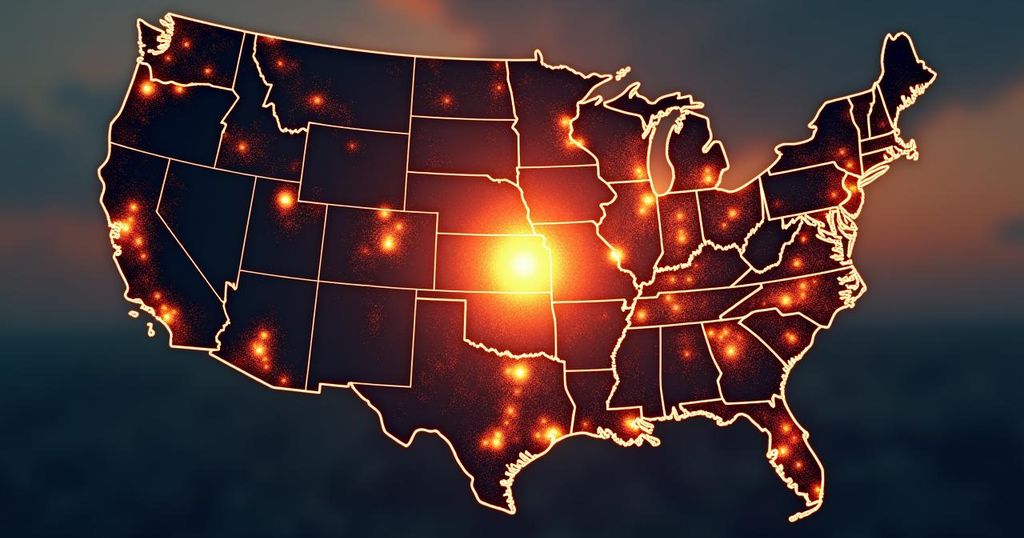4.1 Magnitude Earthquake Reports Surge Across the United States, Including Dillon, Montana
A 4.1-magnitude earthquake struck Dillon, Montana, on October 7, 2024, at a depth of 13.7 kilometers. This event is part of a series of recent seismic activities, including a 3.7-magnitude earthquake in California and a 2.5-magnitude quake in Tennessee within the same week. The United States Geological Survey recorded numerous reports of tremors felt by residents in Montana, emphasizing the ongoing pattern of seismic events across various states.
On October 7, 2024, a 4.1-magnitude earthquake occurred in Dillon, Montana, as reported by the United States Geological Survey (USGS). The quake struck at a depth of 13.7 kilometers (approximately 8.5 miles) and elicited 120 reports from residents who felt the tremor. This earthquake in Montana follows closely after a series of seismic events across the United States. Specifically, a 3.7-magnitude earthquake had taken place in California on October 5, 2024, centered in Petrolia at a depth of 10.0 kilometers (roughly 6.2 miles). Prior to that, a 2.5-magnitude earthquake was reported in Tennessee on October 3, occurring at a depth of 9.7 kilometers (about six miles). Earlier in the week, on October 2, a 3.5-magnitude earthquake occurred off the coast of Oregon at a depth of 13.5 kilometers (approximately 8.4 miles). On the preceding day, October 1, California experienced another 3.5-magnitude quake centered in Avenal, with a depth of 11.4 kilometers (about seven miles), alongside another similar magnitude event in Ontario at a depth of 4.1 kilometers (about three miles). This series of seismic activity can be traced back to September 30, when a 2.7-magnitude earthquake was recorded in Idaho, centered in Bonners Ferry at a depth of 9.1 kilometers (about 5.7 miles). Prior to that, a notable 6.3-magnitude earthquake struck near the Réunion region of Mauritius on September 26, with a depth of 10.0 kilometers (approximately six miles), occurring shortly after a 4.0-magnitude quake in Saanichton, Canada. The seismic fluctuations continued with a 5.2-magnitude earthquake in Romania on September 16, centered in Cașoca at a significant depth of 133.5 kilometers (about 83 miles). This date also registered a 5.1-magnitude quake in Ackerly, Texas, at a depth of 8.2 kilometers (around 5.1 miles). Notably, on September 19, a 3.4-magnitude earthquake was documented in Danville, Kansas. In summary, the seismic activities across multiple states and regions demonstrate a notable pattern of earthquakes occurring within a short time frame, emphasizing the unpredictable nature of geological events.
Earthquakes present a significant geological hazard, impacting various regions across the globe. The United States Geological Survey actively monitors seismic activity and provides timely reports to keep the public informed. Recent earthquakes in the U.S. have highlighted the frequency of seismic events, especially in areas historically prone to such activities. The reporting of magnitude, depth, and location of these earthquakes is crucial for understanding their potential impact on communities and infrastructure.
In conclusion, the 4.1-magnitude earthquake in Dillon, Montana, is part of a larger pattern of seismic activity that has affected numerous regions in the United States in recent weeks. This sequence of earthquakes, ranging from states like California and Tennessee to Idaho and Oregon, underscores the ongoing seismic dynamics that warrant close monitoring and readiness. It is imperative for residents in earthquake-prone regions to remain informed and prepared for possible future occurrences.
Original Source: www.iheart.com




Post Comment